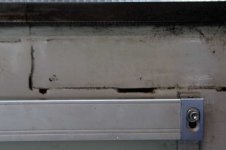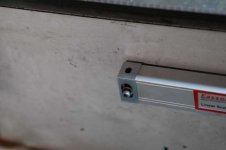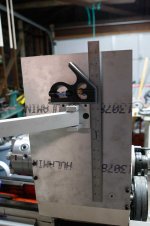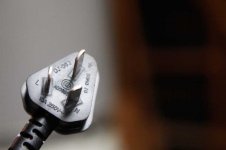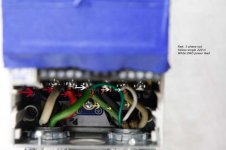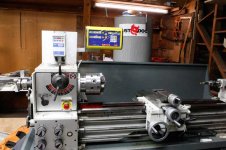You are using an out of date browser. It may not display this or other websites correctly.
You should upgrade or use an alternative browser.
You should upgrade or use an alternative browser.
DRO and VFD install with pics
- Thread starter pescadoman
- Start date
Advice:
1. Take your time, plan everything out and write it all down. YMMV, but I would set aside 2 days. If you have all the tools you need and only make ONE trip to the store, it could be done in a day(I'd be very impressed though if noone was helping).
2. Buy extra fasteners.
3. Go slow with the tapping. I have tapped before, went slowly and something still went wrong(I imagine the tap got cocked somehow on the way out, but in the aid I wouldn't think that a problem)....
4. I am a novice at all this and still managed to get it done with what I consider a min of problems, so it isn't above ANYONE'S skill level. Lathes that are offered with DRO's included must be installed using jigs and specific parts. Don't get discouraged if it takes longer than you thought.
1. Take your time, plan everything out and write it all down. YMMV, but I would set aside 2 days. If you have all the tools you need and only make ONE trip to the store, it could be done in a day(I'd be very impressed though if noone was helping).
2. Buy extra fasteners.
3. Go slow with the tapping. I have tapped before, went slowly and something still went wrong(I imagine the tap got cocked somehow on the way out, but in the aid I wouldn't think that a problem)....
4. I am a novice at all this and still managed to get it done with what I consider a min of problems, so it isn't above ANYONE'S skill level. Lathes that are offered with DRO's included must be installed using jigs and specific parts. Don't get discouraged if it takes longer than you thought.
I hope the 1/4 20 tap came with a #7 drill, not a #9!!
"I went to Lowe's after my tool supplier was closed and bought a 1/4-20 with a number 9 bit included and was very sorry"
"I went to Lowe's after my tool supplier was closed and bought a 1/4-20 with a number 9 bit included and was very sorry"
I hope the 1/4 20 tap came with a #7 drill, not a #9!!
"I went to Lowe's after my tool supplier was closed and bought a 1/4-20 with a number 9 bit included and was very sorry"
My mistake. It came with a 9. Both were garbage.
Nice work Pesc.
Thank you. I have gained more than I have contributed so far...so I THANK THIS FORUM...Even the instructions that come with the DRO is not this well explained.
A very good post and effort to share.
Nice work. Thanks for sharing.
Curious how you work out the VFD. Do you tend to keep the lathe in one gear and adjust the VFD for speed changes? Does this work for a wide range of speeds, or do you find you still have to change the gearing for certain task.
Do you have to turn the lathe on and off from the vfd? Or you can still use the lathe's carriage switch.
Sorry for the basic questions. I know a little about VFD's and how they work but never actually used one.
Curious how you work out the VFD. Do you tend to keep the lathe in one gear and adjust the VFD for speed changes? Does this work for a wide range of speeds, or do you find you still have to change the gearing for certain task.
Do you have to turn the lathe on and off from the vfd? Or you can still use the lathe's carriage switch.
Sorry for the basic questions. I know a little about VFD's and how they work but never actually used one.
Nice work. Thanks for sharing.
Curious how you work out the VFD. Do you tend to keep the lathe in one gear and adjust the VFD for speed changes? Does this work for a wide range of speeds, or do you find you still have to change the gearing for certain task.
Do you have to turn the lathe on and off from the vfd? Or you can still use the lathe's carriage switch.
Sorry for the basic questions. I know a little about VFD's and how they work but never actually used one.
The VFD, as I am using it, simply converts single to three phase. Took 220 from the house in and the 3 phase out to the lathe. Everything on the lathe works exactly as it should, even the coolant pump. Gears are changed on headstock The VFD also has a slew of other features which I haven't used like instant reverse, dynamic braking..ect. I've never spun up the HZ as 2000 seems fast enough.
The company I bought the drive from two years ago was Drives Direct in Orange and were not only the least expensive, but spent a good deal of time on the phone with me. The Leeson/ACTech support was also fantastic, as there were questions about the 2 speed motor.
I just bought a 3hp VFD from them and it was 250.00. ACTech and Leeson are the same drives.
Nice work. Thanks for sharing.
Curious how you work out the VFD. Do you tend to keep the lathe in one gear and adjust the VFD for speed changes? Does this work for a wide range of speeds, or do you find you still have to change the gearing for certain task.
Do you have to turn the lathe on and off from the vfd? Or you can still use the lathe's carriage switch.
Sorry for the basic questions. I know a little about VFD's and how they work but never actually used one.
I have a few answers for you as I've been using VFDs for a number of years now. A VFD can have a number of different features depending on what model you acquire. Mine converts single phase to three phase (not all do this), through settings can run from 0 hertz through 180, will brake as slow or fast as you want through settings, and of coarse has reverse. In the USA electricity is normally 110-120 60 hertz. 3 phase motors RPMs are set for this standard. Say 1740 rpm at 60 hertz. At 30 Hertz the motor will be going half that speed, at 10 hertz it will be going around 175 RPM. Now you can also set your limits to go all the way to 180 hertz which would triple the speed of your motor to 5220 RPM.
Since you are running 3 phase you cannot hurt your motor going from full speed in one direction and throwing it into reverse so that it can run at full speed in the other but be a ware that although it will not damage the motor it could possible destroy the machine. If your lathe spindle has a screw on plate this sudden reverse can unscrew the chuck and you may catch it a couple of blocks down the street. I have my lathes wired so that my normal on/off forward/reverse lever on the lathe controls those operations as they always have. I have the VFD mounted above the lathes and use the rheostat on it to control the speed or to jog the lathe slowly. My lathes came with a 1720 RPM single phase 220 motor and I changed them to 3440 RPM 3 phase motors for the extra speed. I keep my belt on a lower speed and use the VFD to attain whatever speed that I desire without going so quickly that the chuck may explode. Right now my lathes will run between 0 and about 2300 RPM on this lower belt setting. If I want to cut threads I sometimes lower the belt setting or throw in the back gear so that I can run as slow as 3 or 4 RPM and still have plenty of power so that the motor doesn't stall.
After getting my first set-up I don't know how I went for so many years without one. It really makes it so much easier and quicker.
Dick
I have a few answers for you as I've been using VFDs for a number of years now. A VFD can have a number of different features depending on what model you acquire. Mine converts single phase to three phase (not all do this), through settings can run from 0 hertz through 180, will brake as slow or fast as you want through settings, and of coarse has reverse. In the USA electricity is normally 110-120 60 hertz. 3 phase motors RPMs are set for this standard. Say 1740 rpm at 60 hertz. At 30 Hertz the motor will be going half that speed, at 10 hertz it will be going around 175 RPM. Now you can also set your limits to go all the way to 180 hertz which would triple the speed of your motor to 5220 RPM.
Since you are running 3 phase you cannot hurt your motor going from full speed in one direction and throwing it into reverse so that it can run at full speed in the other but be a ware that although it will not damage the motor it could possible destroy the machine. If your lathe spindle has a screw on plate this sudden reverse can unscrew the chuck and you may catch it a couple of blocks down the street. I have my lathes wired so that my normal on/off forward/reverse lever on the lathe controls those operations as they always have. I have the VFD mounted above the lathes and use the rheostat on it to control the speed or to jog the lathe slowly. My lathes came with a 1720 RPM single phase 220 motor and I changed them to 3440 RPM 3 phase motors for the extra speed. I keep my belt on a lower speed and use the VFD to attain whatever speed that I desire without going so quickly that the chuck may explode. Right now my lathes will run between 0 and about 2300 RPM on this lower belt setting. If I want to cut threads I sometimes lower the belt setting or throw in the back gear so that I can run as slow as 3 or 4 RPM and still have plenty of power so that the motor doesn't stall.
After getting my first set-up I don't know how I went for so many years without one. It really makes it so much easier and quicker.
Dick
Excellent info...
